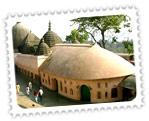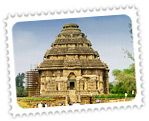Temples

The temple is the focus for all aspects of everyday life in the Hindu community - religious, cultural, educational and social. The temple is also the place where one can transcend the world of man.
Hindus believe that their lives are merely stages in the progression to ultimate enlightenment. The temple is a place where God may be approached and where divine knowledge can be discovered. All aspects of the Hindu temple focus on the goal of enlightenment and liberation - the principles of design and construction, the forms of its architecture and decoration, and the rituals performed. And all of these are determined by ancient texts called shastras compiled by the priests, the brahmins. The vastushastras were theoretical and idealised descriptions of the architectural traditions and conventions to be followed.
The temple is designed to dissolve the boundaries between man and the divine. Not merely his abode, the temple 'is' God. God and therefore by implication the whole universe is identified with the temple's design and actual fabric. The ground plan is perhaps the best example. The vastushastras describe it as a symbolic, miniature representation of the cosmos. It is based on a strict grid made up of squares and equilateral triangles which are imbued with deep religious significance. To the Indian priest-architect the square was an absolute and mystical form. The grid, usually of 64 or 81 squares, is in fact a mandala, a model of the cosmos, with each square belonging to a deity. The position of the squares is in accordance with the importance attached to each of the deities, with the square in the center representating the temple deity; the outer squares cover the gods of lower rank.
 The temple is the focus for all aspects of everyday life in the Hindu community - religious, cultural, educational and social. The temple is also the place where one can transcend the world of man.
Hindus believe that their lives are merely stages in the progression to ultimate enlightenment. The temple is a place where God may be approached and where divine knowledge can be discovered. All aspects of the Hindu temple focus on the goal of enlightenment and liberation - the principles of design and construction, the forms of its architecture and decoration, and the rituals performed. And all of these are determined by ancient texts called shastras compiled by the priests, the brahmins. The vastushastras were theoretical and idealised descriptions of the architectural traditions and conventions to be followed.
The temple is designed to dissolve the boundaries between man and the divine. Not merely his abode, the temple 'is' God. God and therefore by implication the whole universe is identified with the temple's design and actual fabric. The ground plan is perhaps the best example. The vastushastras describe it as a symbolic, miniature representation of the cosmos. It is based on a strict grid made up of squares and equilateral triangles which are imbued with deep religious significance. To the Indian priest-architect the square was an absolute and mystical form. The grid, usually of 64 or 81 squares, is in fact a mandala, a model of the cosmos, with each square belonging to a deity. The position of the squares is in accordance with the importance attached to each of the deities, with the square in the center representating the temple deity; the outer squares cover the gods of lower rank.
The temple is the focus for all aspects of everyday life in the Hindu community - religious, cultural, educational and social. The temple is also the place where one can transcend the world of man.
Hindus believe that their lives are merely stages in the progression to ultimate enlightenment. The temple is a place where God may be approached and where divine knowledge can be discovered. All aspects of the Hindu temple focus on the goal of enlightenment and liberation - the principles of design and construction, the forms of its architecture and decoration, and the rituals performed. And all of these are determined by ancient texts called shastras compiled by the priests, the brahmins. The vastushastras were theoretical and idealised descriptions of the architectural traditions and conventions to be followed.
The temple is designed to dissolve the boundaries between man and the divine. Not merely his abode, the temple 'is' God. God and therefore by implication the whole universe is identified with the temple's design and actual fabric. The ground plan is perhaps the best example. The vastushastras describe it as a symbolic, miniature representation of the cosmos. It is based on a strict grid made up of squares and equilateral triangles which are imbued with deep religious significance. To the Indian priest-architect the square was an absolute and mystical form. The grid, usually of 64 or 81 squares, is in fact a mandala, a model of the cosmos, with each square belonging to a deity. The position of the squares is in accordance with the importance attached to each of the deities, with the square in the center representating the temple deity; the outer squares cover the gods of lower rank.



















